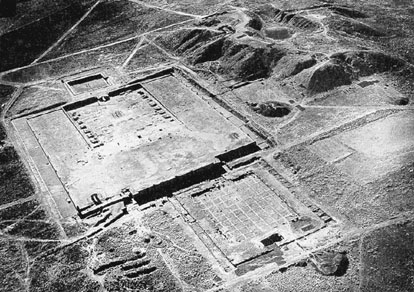

 | Page 167 |  |
Kalasasaya, and Putuni. However, written material documenting these findings remains scarce, and part of the excavated material was transported to the Musée de l’Homme in Paris (Ponce Sanginés 1995).

Aerial photograph of Tiwanaku
(Marilyn Bridges)
From 1932 to 1934, Wendell C. Bennett from the Museum of Natural History, New York City, made a series of excavations and test pits around Tiwanaku, Lukurmata, Pajchiri, and Chiripa in the Bolivian highlands and other prehistoric sites in the Cochabamba valleys such as Arani. Bennett’s main contribution was to establish a relative chronology based on stylistic ceramic changes over time, and his chronology is still the basis for modern archaeological studies. The excavations, coordinated with the Bolivian National Museum, provided a great number of finds that were later transported to the Museum of Natural History in New York City (Bennett 1934, 1936; Ponce Sanginés 1995).
Starting in 1940 and continuing for several years, the Argentine Dick E. Ibarra Grasso undertook small-scale excavations and artifact collection in different Bolivian regions, and he was one of the first to identify a number of local archaeological cultures in Bolivian valleys such Mojocoya, Tupuraya, Nazcoide-Omereque, Yampara, Yura, and Uruquilla. He also provided a relative chronology and local sequence for these archaeological cultures, and the materials he collected constituted the bases for regional museums throughout Bolivia (Ibarra Grasso and Querejazu Lewis 1986).
During 1938, the Swedish archaeologist Stig Rydén from the Ethnographic Museum of Göteborg conducted a series of excavations in Tiwanaku and Wankani. He confirmed Bennett’s chronological sequence, identified Tiwanaku’s domestic ceramic assemblage, and recognized post-Tiwanaku cultural components in the highlands. During 1951–1952, Rydén conducted excavations in the intermediate valleys of La Paz (Muñecas, Bautista Saavedra), in the Cochabamba valleys (Tupuraya) and in Oruro (Cayhuasi), collecting and providing detailed artifact inventories of the local cultural components of these areas, including the post-Tiwanaku funerary towers (chullpas) from the
 |  |